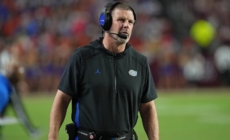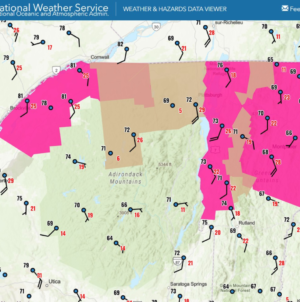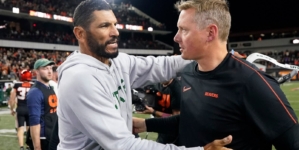-
Red Flag Warnings Issued in These States: What To Know - 24 mins ago
-
Sam Rivers, Bassist for Limp Bizkit, Dies at 48 - 26 mins ago
-
Healthcare workers strike at Kaiser Permanente ends after 5 days - 30 mins ago
-
Panthers’ Bryce Young Exits Game With Worrisome Ankle Injury - about 1 hour ago
-
U.S. Kills 3 on Boat Suspected of Smuggling Drugs for Colombian Rebels - about 1 hour ago
-
College Football Program Fires Coach After 12-Point Loss - 2 hours ago
-
A Fragile Cease-fire Between Afghanistan and Pakistan Ends Violence, for Now - 2 hours ago
-
Dodgers’ Mookie Betts Sends Message to Brewers After NLCS - 2 hours ago
-
Epoch Times Reporter Resigns After Publication Signs Pentagon Rules - 3 hours ago
-
Florida Fires Billy Napier After Two-Point Win - 3 hours ago
Can $50 Billion “Transform” Rural Health Care? Leaders Doubt It
This is a preview of the October 16 edition of Access Health—Tap here to get this newsletter delivered straight to your inbox.
Good morning from Sioux Falls, South Dakota!
I’ve been here all week, touring the facilities and meeting physicians and staff members at Sanford Health—the largest rural health system in the U.S. On Tuesday, I joined policymakers and health care executives in the Sanford Barn for the 4th Annual Summit on the Future of Rural Health Care.
The Summit felt particularly timely this year, several attendees told me. Rural health has been gaining national attention amid looming Medicaid cuts, as about 1 in 4 rural patients are covered by the program. Between 2005 and 2023, 146 rural hospitals shuttered or converted to non-acute status, according to the U.S. Department of Agriculture. For many Americans in outlying communities, care access is on shaky ground.
Stabilization efforts are underway, like CMS’s new Rural Health Transformation Fund. The program will allocate $50 billion to approved states over five years, beginning in 2026.
Will it actually make a difference? It depends on who you ask.
Dr. Mehmet Oz called into Tuesday’s Summit to give virtual remarks, and the CMS administrator spoke highly of the Fund’s potential.
“The best practices that we discover to help scale health care more effectively in rural America will also work in urban America, suburban America, other counties,” Oz said in a roughly 20-minute speech. “So let’s use this grand experiment, this five-year effort, to transform health care, to start with rural health care, but spread the wisdom.”
Some of the folks I spoke with (on background) were less enthusiastic. One executive raised concerns about the program’s viability for health systems that span multiple states—and could see funds dispersed unevenly across their geographies, unbalancing regional programs. Another was stressing about the tight timeline; states must submit their proposals to CMS by November 5, giving them less than two months to pull together a viable application. It’s not an easy ask, and many of CMS’ suggestions—attracting more workers, standing up new access points and making rural facilities techier—could require new policies at the state and local levels.

“We can waste a lot of money very quickly, unless we’re really thoughtful about investing it in programs that actually are not only sustainable, but going to get us to a different place,” Dr. Joanne Conroy, president and CEO of Dartmouth Health, said on a CEO panel that I moderated at the Summit. “And it’s interesting, because I’m in Vermont and New Hampshire, and they’re preparing to submit their plans, actually, very differently…I’m worried, though, because we do have a history of using some of these funds in things that are not sustainable.”
The government calls this a “historic” investment in rural health care. When I asked rural health care leaders about that verbiage, they went heavy on the air quotes. Some said it was a straight-up stretch.
Under HR1, Medicaid and CHIP will be cut by nearly $1 trillion over the next decade, so in context, $50 billion over five years isn’t that good of a make-good. How does a rural health system support a costly workforce initiative or data security program without long-term funding security? How do they do it while a critical source of revenue whittles away?
On that same CEO panel at the Summit, Bill Gassen, CEO of Sanford Health, suggested that one-time expenditures, like getting AI into rural hospitals that would “never be able to afford it on their own,” could be a better use of the funds than long-term projects that would outlive the money.
“We have a rich history in this country of making poor use of one-time dollars and creating more than one-time dollar programs,” Gassen said. “And we need to make sure we don’t develop an unfunded mandate for ourselves going into the future.”
Still, no rural hospital is in a position to turn down a check. The willingness to accept short-term relief says as much about the fragility of rural health care as it does about Washington’s approach to fixing it.
“Listen, it’s an opportunity, and nobody’s going to say that we can’t utilize this opportunity,” Rick Pollack, CEO of the American Hospital Association, told me on Tuesday. “Is it going to really result in dealing with sustainability for many of these organizations? I don’t think so.”
“Is it a pathway that can bring some innovations and help out in some targeted ways that could help sustainability?” he continued. “Yeah, no question about that, but it’s not the magic bullet that will compensate for the challenges that these folks are facing in terms of the Medicaid cuts and other challenges that are out there, like with the commercial insurance companies.”
“To be honest about how it’s gonna play out right now, in one state or another, I really don’t have a good answer for you.”
In Other News
Major health care headlines from the week
- Open enrollment for Medicare began yesterday as the government shutdown entered its second week. Updates to information on the Medicare.gov website could be delayed due to the shutdown, and seniors can expect customer service to be short-staffed, my Newsweek colleagues reported.
- “The government shutdown is not going to affect Medicare or the plans that are being presented. However, seniors should expect delays in the processing of applications if they are looking to make a change this AEP (annual enrollment period),” Chris Fong, a Medicare specialist and the CEO of Smile Insurance Group, told Newsweek.
- Fong said that some seniors who are losing their Medicare Advantage plan will be guaranteed approval for a Medigap policy but recommended that they consult with a Medicare insurance agent to discuss options.
- Tens of thousands of Kaiser Permanente workers began a strike on Tuesday, which is expected to last five days. More than 52,000 Kaiser workers’ contracts expired between September 30 and October 1 after their unions and the California-based health system failed to reach an agreement.
- Understaffing, fair pay and retirement security are at the heart of the disagreement, according to the United Nurses Associations of California/Union of Health Care Professionals (UNAC/UHCP), which represents thousands of affected workers. The health system holds $64 billion in reserves while wages remain stagnant, the union said in a statement.
- Kaiser disputed the union’s claims, telling Newsweek that workers in the Alliance of Health Care Unions are already paid about 16 percent above market rates. The health system’s current offer would raise wages by 21.5 percent over four years. The union is gunning for a 25 percent increase, which, in turn, would raise costs for health plan members, Kaiser said.
- Medical schools across the U.S. are expanding in an attempt to combat the physician shortage—which could be exacerbated by a new $100,000 fee on H1-B visa applications. Nearly a quarter of practicing physicians in the U.S. are international medical graduates, according to the American Medical Association.
- Last week, the state of Rhode Island released a feasibility study on the benefits of opening a medical school at its flagship university. And in recent months, new medical schools have opened in Bentonville, Arkansas, and Charlotte, North Carolina, while universities in Oregon, Minnesota and New Mexico shared plans to expand their health care programs. Get the full scoop at Newsweek.
- Contract negotiations are heating up between payers and providers. UnitedHealthcare reached a deal with Ascension Wisconsin—but during the monthslong dispute, many patients fell out of network with Ascension and reported scheduling backups as they looked to get on other providers’ books, according to a local news station. Bronson Healthcare in Michigan also entered contract negotiations with UnitedHealthcare this week as a regional South Carolina system extended their talks with the insurance giant.
- UnitedHealthcare isn’t the only payer on the fritz with health systems. Bon-Secours Mercy Health in Ohio told Medicaid and Medicare Advantage (MA) patients managed by Humana that their providers may be out of network if the parties don’t reach an agreement by December 1.
- Multiple insurers are pulling their Medicare Advantage plans from certain counties as the cost of care continues to rise. MA may not be viable in some markets due to these “contract fractures,” said Molly Smith, group vice president for public policy analysis and development at the American Hospital Association, at Tuesday’s Summit on the Future of Rural Health Care.
Pulse Check
Executive perspectives on key industry issues

On October 1, Dr. John D’Angelo took the helm at Northwell Health, the largest nonprofit health system in the Northeast. He has been with the New York-based health system for 25 years, beginning as an emergency medicine physician and most recently serving as senior vice president of emergency care.
D’Angelo is assuming the CEO role at a critical time for Northwell. The system is undergoing an Epic implementation and merged with Nuvance Health in May, expanding its acute care footprint into Connecticut. And as the successor to Michael Dowling—Northwell’s CEO for more than two decades, who has stewarded its growth from a two-hospital system in 1995 to the modern, $23 billion enterprise it is today—D’Angelo has big shoes to fill.
I sat down with D’Angelo seven days into his tenure for a Pulse Check. We discussed his first day, his future outlook and the core principles that will ground his own legacy. Find a portion of our interview below.
Editor’s Note: Responses have been lightly edited for length and clarity.
John, it’s been about a week since you became the CEO of Northwell Health. What’s been top of mind for you in these first few days?
I’ve been in transition mode since mid-May, when I was selected and announced [as CEO], so, it has felt like I’ve been in the seat since May, although I don’t know, I guess, until I see what it really feels like going forward.
But Michael [Dowling has] been great. He’s been deferring a lot of major decisions to me in the four months leading up to October 1, and [I’ve been] spending a lot of time listening, learning, even though I’ve been in the organization for 25 years. [I’ve been] really meeting with a lot of the key stakeholders, asking questions and listening from a different perspective now, a different angle.
My senior leadership team—there are about six or seven other major roles of folks who are phenomenal—but they’ve been here with Michael since his start here. So there are a lot of retirements coming up in the next six to nine months. Some are already announced.
It creates an opportunity for me. We have a deep bench with excellent people, and an opportunity to bring some outside or external perspectives. So thinking about my senior leadership team, what kind of roles and competencies are needed for the future and what is the right operating model of that leadership structure, given the fact that the organization has been rapidly changing.
But the biggest driver of that change has been the Nuvance [Health] merger, which occurred May 1, so we now have a much bigger geography to cover, multi-state on the hospital side. We’ve been multi-state on the ambulatory side for years, but it just forces us to think about our operating model and leadership structures. So that’s what I’ve been focusing on in the four months leading up to October 1.
And then [after] October 1, so far I have been really focusing on just getting out there and reassuring people around the stability of the transition. In fact, I really wanted my first day to be meaningful and be engaging with the frontline staff. We had a retirement party that the board organized for Michael last Tuesday night, [September] 30th, that ended at nine [p.m.].
I rested a few hours, and at midnight—stroke of midnight—I showed up at my first hospital, and then I visited six hospitals through the night to six a.m. I walked around, met the night staff at Greenwich Village, Lennox, Hill, Norwalk, Northern Westchester and Phelps and rested a few more hours.
And then by 10 a.m. I hit the road again, and I hit another 10 sites through about 10 or 11 o’clock that night, again, just engaging the frontline staff. And I wanted that to be how I spent my first day.
Long day! Have you recovered from that yet?
Yeah, I have done my share of night shifts over my time, especially when I was clinical. And, you know, you feel a little beat up the next day, but it was definitely worth it, and it was important to me to get out and engage the night staff, because a lot of times their work shifts are not during the time that typically leaders are out there and rounding.
When you were rounding with the night-shift teams, did they tell you about changes they’d like to see in the organization, or wishes they hope you can fulfill?
Yeah, [that] was one of the questions I wanted to ask. What are you most proud of? What do we really need to protect? What do you guys think needs to change?
Maybe because it was the first time meeting this new CEO, [or] maybe a lot of folks were really just expressing a lot of excitement. Team members were very thankful to be visiting, a lot of people wanting to take pictures. There were some very vocal people who are very proud of the work they’re doing and want to tell me about their unit.
The message that carried across most of the places I went was just, you know, an appreciation of the culture of Northwell, and the fact that we’re all aligned around purpose: the patients and the communities we serve are front and center. That resonated well with everyone. You can hear that through their comments.
They express concerns about the landscape, about the future. They hear about the layoffs at some other major organizations, so reassuring them that we’re in a strong position, we’re growing and we can continue to grow. [There were questions about] where else is Northwell going to go next?
Michael Dowling is one of the most influential leaders in the health care industry—you’re stepping into some big shoes. What do you hope to keep from his CEO tenure, and how do you intend to innovate and make the role your own?
One of the things about Michael—one of the things I know I’ve witnessed, and I’ve been a part of over the years—is he’s always pushed the organization to not stand still and to be challenging a status quo. “What do we need to be doing differently?” [is a] part of the normal dialogue around here. He’s built an amazing culture and really a rock-solid foundation.
That’s what I hope to maintain, this quest for wanting to be the best in health care delivery, wanting to be the best in research, discovery, innovation, teaching, wanting to be a top employer of choice, and not just about jobs, but careers for people, and investment in our team members.
[Michael has] also established a real passion in the organization around being an active player in overall societal wellness, and has taken on the tough issues like substance use disorder, gun violence, social determinants of health, and all of that is going to stay front and center for us as an organization. I intend to keep that focus, so that’s what won’t change: our shared mission and purpose.
But then also, how do we be more innovative? I’m very big into certain things like, how do we better leverage technology to enable clinical care delivery? How do we focus more and more on overall health? We still have to do what we do today, which is, manage disease when disease presents itself and manage illness and injury. But how do we be more proactive, precision-based, personalized, and real partners, trusted partners, of all the people we serve in their overall health journey?
I think being a physician CEO kind of gives me some different insights into that. I’ve always been someone who’s driven change and transformation, and at times, been disruptive and challenging us to improve, and I hope to continue to do that. I’ll build upon that foundation that [Michael has] laid for us, certainly.
I know it’s still early, but I imagine you’ve been in some strategy sessions. What’s your plan for a more “proactive” approach to care at Northwell?
We have to really expand access to primary care. Some of that is for traditional primary care and brick-and-mortar offices. We’re about to embark on a very aggressive joint venture partnership on really optimizing 24/7 primary care access through virtual care that is connected to the doctors in the offices.
Over time, what I see happening is, we have a tremendous amount of data on patients that have interacted with us. How do we use our data to more proactively reach out? Example: as we build out our consumer relationship management infrastructure, how do we proactively build pathways that [identify] all the patients that we touch that meet criteria for lung cancer screening? How do we proactively reach out to them and say, “Hey, Mr. So-and-so, based on your history, you would qualify for and would benefit from lung cancer screening. We see you live here, we have these appointments nearby. Can we set you up?”
How do we be more proactive? That’s the short-term environment.
The more long-term vision is, as you think about the real inflection point we are at with how quickly technology is advancing, how do we leverage technology? There’s a platform called Optain, which is a retinal AI-driven device that anybody really can [use] in an office. The technician can put the patient through it. It can be very proactive in getting upstream on diabetes, hypertension and other subtle changes that may not be yet apparent in their vital signs or blood work, like retinal damage and other things [that are] precursors of stroke and heart attack. How do we disperse technology like that into our ambulatory practices?
Then you take it to the next level as we prepare for an aging population. We have growing numbers of folks living longer, but with chronic disease, and we’re not going to have the capacity 10 years from now to manage that in the traditional way, as far as number of hospital beds, if we just keep treating people the way we do.
So longer term, how do we really think differently around care models? What does that home-based or community-based workforce of the future look like, and what are their capabilities, and how are they digitally enabled? How are they tied to patients? Through technology the patients have at their disposal, whether that be Bluetooth blood pressure cuffs, oxygen measurement tools, scales…maybe in some folks, smart clothing that can detect change in their gait and tell us they’re at a risk of fall. There’s so many things out there that are coming out that we should take advantage of.
C-Suite Shuffles
Where health care leaders are coming and going
- Longitude Health named Dr. Vishal Agrawal its CEO on Wednesday.
- Agrawal, former chief strategy and corporate development officer at Humana, will oversee the nonprofit health system coalition designed to develop business solutions for health care administration.
- Baylor Scott & White Health, Memorial Hermann, Michigan Medicine, Novant Health and Providence are members of Longitude Health, which has two software offerings around pharmaceutical administration and financial management. Read more at Newsweek.
- CommonSpirit Health tapped Michael Browning as senior executive vice president and CFO.
- Browning joins the Chicago-based system from OhioHealth, where he also served as CFO. In his new role, he will oversee finances for the sprawling CommonSpirit—which includes 138 hospitals across 24 states.
- Molly O’Neill is the new chief commercial officer at Ascertain, a spinoff formed from a partnership between Northwell Health in New York and Aegis Ventures, a “startup studio” aimed at scaling health tech companies.
- Most recently, O’Neill was Aegis Ventures’ chief strategic partnerships officer. She has also served as vice chancellor for Duke Health in addition to holding leadership roles at Medforth Global Healthcare Education Group, Tenet Healthcare, Mass General Brigham, Ascension Health Care Network and Inova Health System, my colleague Aman Kidwai reports.
- As incidents of violence towards health care workers tick upward across the health care industry, Franciscan Missionaries of Our Lady Health System has selected Eric Clay as its chief security officer.
- Clay previously held leadership roles in security at The Walt Disney Company and served in the U.S. Federal Air Marshal Service. He now joins Louisiana-based Franciscan Missionaries of Our Lady from Memorial Hermann Health System in Houston, where he directed a $30 million security budget across the enterprise.
Executive Edge
How health care execs are managing their own health

I spent part of my Monday at Sanford Health’s Virtual Care Center in Sioux Falls, South Dakota. One of my tour guides was Dr. Nathan Skelley, an orthopaedic surgeon specializing in sports medicine at the health system who also serves as an associate professor at the University of South Dakota and as the medical director for the USD Athletics Department.
That’s him (in the image below, on the left), showing me (on the right) how the health system uses virtual reality to prepare medical students and residents for surgery.
We also stopped by the Virtual Care Center’s 3D printer, where Skelley and his team work to develop cost-effective medical devices. He told me that balancing his clinical work with a creative outlet helps reduce his risk of burnout (and as a busy medical professional, that risk is high). I’ll let him explain in writing:
Editor’s Note: Responses have been lightly edited for length and clarity.
“In today’s health care climate, there are many different forces that demand a physician’s time. Physician burnout is a pervasive problem in health care with significant implications for doctors, patients, and the entire health care system. Physician burnout is a long-term stress reaction identified by three main factors: emotional exhaustion, depersonalization and lack of personal accomplishment. Hospital systems across the country are working to find resources and avenues to combat the rising problem of physician burnout.
The Virtual Care Center is part of a larger virtual health initiative at Sanford Health focused on education, innovation, new technologies and clinical care delivery. Through this center and its associated programs, medical professionals like me are able to explore new technologies, resources and skillsets to help avoid the clinical stressors leading to burnout. This unique center not only encourages creative and out-of-the-box thinking for medical professionals to solve various health care problems, but it also supplies the physical space, team members and resources to pursue this work.

I became very intrigued with the concept that low-cost desktop 3-D printing technologies could improve access and care delivery in the field of orthopaedics. I never dreamed of learning skills like 3-D printing or Computer-Aided Design during my medical training at Johns Hopkins, Washington University in St. Louis and Harvard Medical School. However, my medical students from the University of South Dakota now see the impact of this technology in my clinic and operating room every week.
The Sanford Health Virtual Care Center has multiple 3-D printers that medical professionals can use to learn, study, and explore improved care delivery. I have received several national research grants to study 3-D printed knee braces to improve patient mobility and function after injuries and surgeries. I have also designed medical prototypes to develop industry collaborations for making new medical devices. My patient specific 3-D anatomic models have also improved patient education and understanding of orthopaedic pathology and surgical treatments. Furthermore, the 3-D models I have created help with surgical planning and simulation before entering the operating room for complex cases.
I have found that the resources and services of the Virtual Care Center provide an outlet where I can explore new technologies, develop new solutions to various health care problems, and apply my medical training and skills to an area of medicine that is very different from the work I perform in the clinic and operating room. This work has provided a greater sense of professional accomplishment, value-added service and emotional fulfillment that helps improve my job satisfaction. I am very grateful to work at a health system that provides unique outlets like Virtual Care and 3-D printing technologies to improve patient care—and improve the well-being of the medical professionals caring for these patients.”
This is a preview of the October 9 edition of Access Health—Tap here to get this newsletter delivered straight to your inbox.
Source link




















